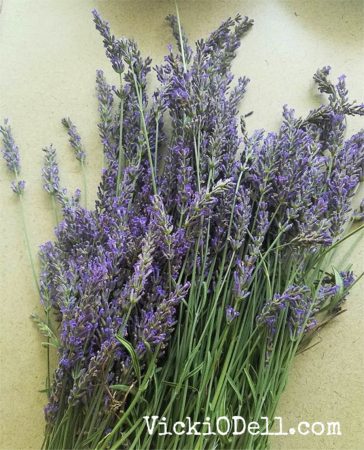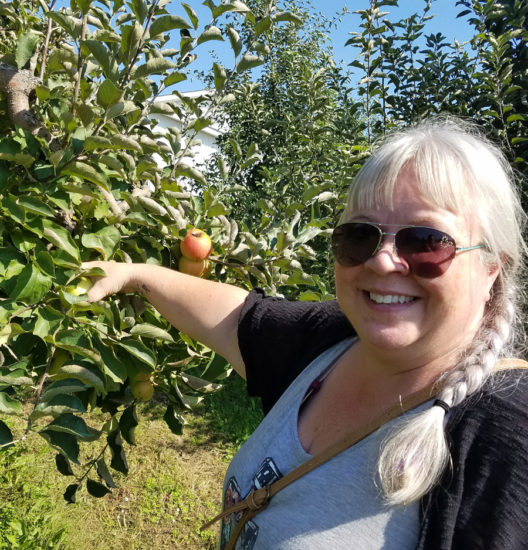 Lavender grown here at Thank Goddess FarmIn my mind lavender is just about the best thing on this little blue marble we call home. I could roll around in a giant pile of lavender and still not get enough of it. I think that it smells like earth, wind, rain and sunshine all at once. It is a scent that calms and soothes me while at the same time making me feel giddily happy. There must be some experience from my past (past life?) regarding lavender that I key into every time I smell it. Lavender is home.
Lavender grown here at Thank Goddess FarmIn my mind lavender is just about the best thing on this little blue marble we call home. I could roll around in a giant pile of lavender and still not get enough of it. I think that it smells like earth, wind, rain and sunshine all at once. It is a scent that calms and soothes me while at the same time making me feel giddily happy. There must be some experience from my past (past life?) regarding lavender that I key into every time I smell it. Lavender is home.
Lavender
Lavandula (common name lavender) is a genus of 47 known species of flowering plants in the mint family, Lamiaceae.
Lavender is an aromatic perennial evergreen shrub. Its woody stems bear lavender or purple flowers although there are varieties with blossoms of white or pink.
The flowers bloom from the month of June through September in the fall, however, the blooms of one variety persist a little longer – the L. latifalia – into late fall.
Botanical Name(s)
Lavandula x intermedia Emeric ex Loisel.
Plant Family: Lamiaceae
Where It Grows
Lavender is native to the Mediterranean and is a common sight in Southern Europe, but now cultivated in cool-winter, dry-summer areas in Europe and the Western United States. The plant grows best at sites with a good exposure to sunlight; in general, the lavender prefers dry and sunny places for optimal growth.
Part Used
Flowers
Collection
The best time to harvest lavender is before the last blooms on each individual stalk have fully opened up. Generally, dry days are best for harvesting, the harvesting is done in the morning before sunlight has evaporated the essential oils present in the flowers. The floral stalks are harvested and tied in neat bundles and hung to dry in a warm, shady and airy area. Several weeks may pass before the flowers become completely dry.
When the floral stalks become crisp to the touch, the flowers are stripped off the stems and these are stored in airtight containers and kept in a dark place. Cookie sheets may also be used to dry the stalks; the stalks are laid flat on the surface and dried slowly. To make the best potpourris, it is ideal to use flowers in buds that have just begun to open up.
Main Actions
The scent of the lavender has been prized for thousands of years and the plant has been valued as a scented herb in many civilizations of the past. The mind and the body can be relaxed and soothed by the scent of the flowers, a herbal infusion, or herbal tincture made from the essential oil of lavender.
Lavender is effective in the treatment of prolonged anxiety, chronic and persistent nervousness, as well as in alleviating the physical symptoms induced by excessive stress such as tension headaches, persistent migraine, cardiac palpitations and sleep disorders like insomnia.
The emotions are said to be brought into balance by the application of lavender oil, it is said to elevate flagging spirits, and helps in relieving depression.
The stimulating effect of lavender is another potent property of the herb, the remedy brings a tonic effect on the nervous system, and it helps to restore vitality to individuals affected by long-term nervous exhaustion and mental trauma.
Disorders of the digestive tract, in particular, are greatly eased by the relaxing effect of lavender, the herbal remedy soothes muscle spasms and eases colic related to mental tension and anxiety. It is also very effective in helping relieve abdominal distension, in relieving persistent flatulence, spells of nausea as well as indigestion.
The volatile oils in lavender are a powerful antiseptic and have been shown to have a good effect against pathogenic bacteria such as the strains responsible for diseases like diphtheria and typhoid, it is very potent against the streptococcus and pneumococcus strains of bacteria.
Uses
As a spice, lavender is best known as an important aspect of French cuisine and is an integral ingredient in herbs de Provence seasoning blends. Lavender may be used on its own to give a delightful, floral flavor to desserts, meats, and breads. The flowers can also be layered within sugar to infuse it with its distinctive aroma for use in cookies and candies.
Similar to cilantro, some individuals perceive the taste of lavender in a manner that is undesirable within cuisine. An estimated 10% of the population interprets lavender to have a soapy and unsavory flavor. For this reason, it may be wise to exercise caution while using lavender as a flavoring agent.
TYPICAL PREPARATIONS
The herbal remedy can be taken in the form of a herbal tea, it can also be inhaled as dispersed oil or used as a vapor rub. Used topically, lavender is capable of alleviating common colds, chronic coughs, problems such as asthma and persistent bronchitis, pneumonia, flu, persistent tonsillitis and laryngitis in affected individuals. A lavender herbal tea or tincture is also useful for the treatment of stomach and bowel infections that are accompanied by vomiting or diarrhea as symptoms.
When prepared in the form of a hot herbal tea, the remedy made from lavender induces sweating and helps reduce the elevated body temperatures in case of fevers. The body is also detoxified by a lavender remedy; the herb rapidly eliminates accumulated toxins in the body through the skin and the urine as a result of its mild diuretic effect.
A remedy made from lavender is also very effective as an external disinfectant in the treatment of cuts and wounds, helping heal sores and ulcers on the body. The tissue repair and restoration process in the body is also stimulated by the herbal remedy resulting in the minimization of scar formation especially when the volatile oil is applied next to the burns. The diluted oil is used in the treatment of disorders such as eczema, chronic acne and varicose ulcers in the affected person.
Lavender has been thought for centuries to arouse passions as an aphrodisiac, and is still one of the most recognized scents in the world.
